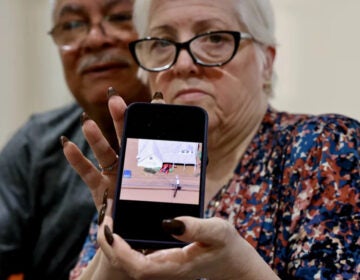Drilling for Earth’s climate secrets buried under the sea
A team of scientists on the JOIDES Resolution drill for sediment cores off the coast of Portugal — an area rich with information about earth's history.
Listen 13:43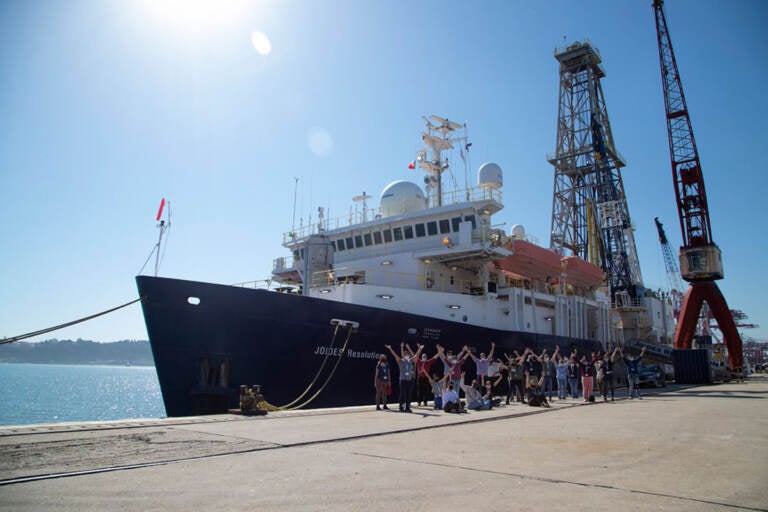
The science party of Expedition 397 arrives at the JOIDES Resolution in Lisbon, Portugal. (Courtesy of Sandra Herrmann, IODP JRSO)
This story is from The Pulse, a weekly health and science podcast.
Find it on Apple Podcasts, Spotify, or wherever you get your podcasts.
Before dawn on a windy day, two dozen climate scientists shiver on the top deck of a research ship, watching as tugboats pull them away from the Port of Lisbon and into a two-month adventure 13 years in the making.
The JOIDES Resolution carries the researchers under the 25th of April suspension bridge, past the Monument to the Discoveries, and into the open ocean. Their destination? A series of stops where they planned to drill deep into the seafloor in search of climate secrets that have accumulated over millions of years.
This field of climate science is known as paleoceanography — the study of oceans in the past – and one of its founders was the late British scientist Sir Nicholas Shackleton. If the name Shackleton sounds familiar, that’s probably because Nick was a great-nephew of the Antarctic explorer Sir Ernest Shackleton. Where his famous great uncle wanted to go far to chart new territory, Nick Shackleton wanted to go deep. He collected cylinders of mud – called sediment cores – from beneath the ocean to piece together a clearer picture of the past.
From analyzing the layers of sand and rock, full of microfossils and minerals, in those cores, Shackleton could calculate the air and water temperature and the amount of carbon dioxide in the atmosphere hundreds of thousands of years ago. And he also determined that the North Atlantic Ocean, just off the coast of Portugal, is a critical place to conduct such studies.
His scientific work earned Shackleton much fame in his field, and lots of awards and medals. But he died in 2006 from cancer, before he was able to finish a major project. He wanted to drill for sediment cores in an area off Portugal’s coast where the bottom of the ocean features hills and canyons that collect sediment from the nearby European continent. It’s also a place where oceanographers have identified water masses from both the Arctic and Antarctic regions. Shackleton’s work showed that this location likely would give scientists cores that would allow them to create a continuous record of Earth’s climate history going back 3-5 million years.
Two researchers, old friends from their graduate student days at the University of Rhode Island, decided they would put forward a request to complete Shackleton’s work in 2009. David Hodell, an American who moved to the United Kingdom in 2008, is at the University of Cambridge, in the Department of Earth Sciences, where Shackleton spent his career. Fatima Abrantes leads a lab at the Portuguese Institute of Sea and Atmosphere in Lisbon and together the two are co-chief scientists of the International Ocean Discovery Program’s Expedition 397.
After about 12 hours at sea, the ship comes to a stop and lowers 12 huge thrusters. These are large propellers enclosed in metal tubes that give the ship’s crew the ability to hold the ship in place.
At 470 feet long, the JOIDES Resolution is a floating 1970s oil rig that was completely remodeled to drill for science instead of fossil fuels in the 1980s. Towering on its deck is a 200-foot-tall derrick. Picture a big, open, ladder-like pyramid, the sort of thing you might see on an oil field. The ship carries a mile’s worth of pipe that gets pieced together section by section to form what’s called the drill string. It turns and turns, stretching from the top of the derrick through a hole in the ship called a “moon pool,” then plunging through about 15,000 feet of water all the way to the bottom of the ocean.
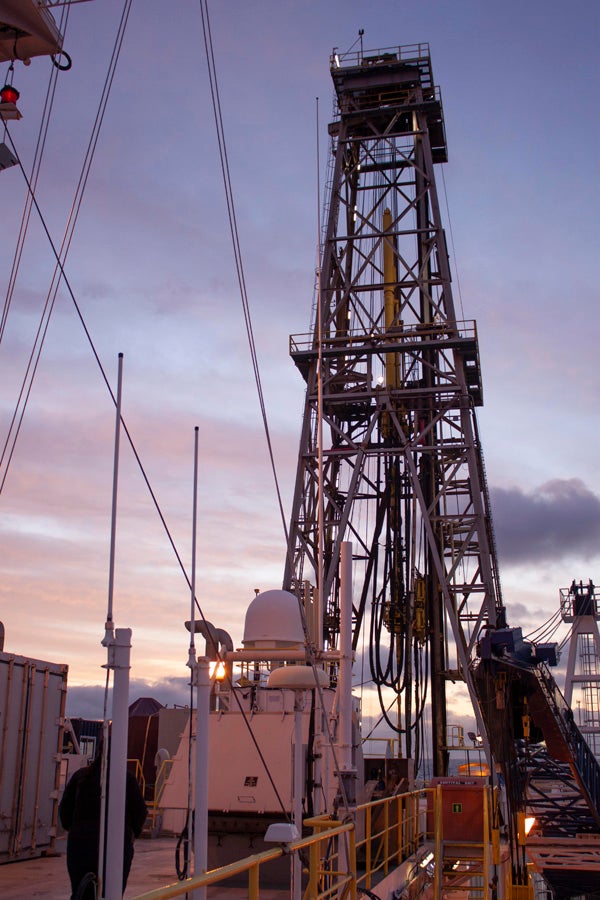
When it reaches the seafloor, the pipe drills into the sediment, starting a hole. Next, the drill crew drops a 30-foot-long plastic tube into the pipe. It has a metal tip and when that enters the hole, it pushes deeper until the entire length of the plastic tube fills with mud.
Subscribe to The Pulse
At that point, the crew uses a series of tools to bring the plastic tube back to the deck and hand it off to the science technicians. They’re waiting in hard hats, safety glasses and steel-toed boots to bring the sediment core onto a catwalk outside the science labs. This is where the research begins.
One after another, empty tubes plunge through ocean and sediment, return to the ship’s deck, and get ushered through the many analyses available onboard.

Why drill here?
The reason Abrantes and Hodell, and Shackleton before them, wanted to drill at these locations is that the seafloor here has a high sedimentation rate — that’s the speed at which sand, pollen and tiny critters settle onto the seafloor. That’s what creates, over millennia, the layers of information the scientists are looking for. That process here is about 10 times faster than in other parts of the ocean.
Hodell says in the 1990s, Shackleton made a ground-breaking discovery at this very location, inspiring this expedition. That trip was not on a drilling vessel. Instead, they used technology that only allowed for shorter cores. On the JOIDES Resolution, the scientists can bring up sediment cores from as deep as 1,600 feet below the seafloor. Shackleton’s cores came from less than 150 feet into the sediment. But Hodell says Shackleton still learned a lot from them.
“He demonstrated that the surface record looked exactly like Greenland and … the bottom record looked exactly like Antarctica,” Hodell said. In other words, Shackleton found that the mud he dug up from just beneath the ocean floor revealed the same details as had been found in ice cores from the poles.
“It must have been like a Eureka moment to say, ‘Aha! this looks exactly like the Greenland ice core record, and this looks like the Antarctic ice core record,’” Hodell said. “He wrote many, many papers about it.”
This breakthrough was huge because it meant the microfossils and pollen and everything else that makes up the sediment on the Iberian margin, this area off the coast of the Iberian Peninsula, could help piece together a more detailed picture of global climate at specific times in Earth’s history.
It takes a lot of chemical analyses and hours at microscopes to analyze samples, but Hodell says there’s no other spot in the world’s oceans that captures records like these.
“It’s kind of mind blowing a bit, that one place in the ocean, one sediment core, can have links and components to both of the poles as well as the European continent,” he said, “but that’s what makes this Iberian margin so special.”
Before Shackleton’s discovery, details about polar air and water temperatures came from ice cores. That meant researchers could only study conditions as far back as there was ice –— about 800,000 years in Antarctica and less than 150,000 years in Greenland.
Now, they can use the sediment from here to create a picture of what the poles were like when Earth was a lot warmer. That will help make current climate models more robust. A better understanding of past climates might also help people prepare for the changes that are coming. Shackleton’s the one who first saw that potential.
“We’re just kind of fulfilling, I feel, his wish, his dream,” Hodell said.
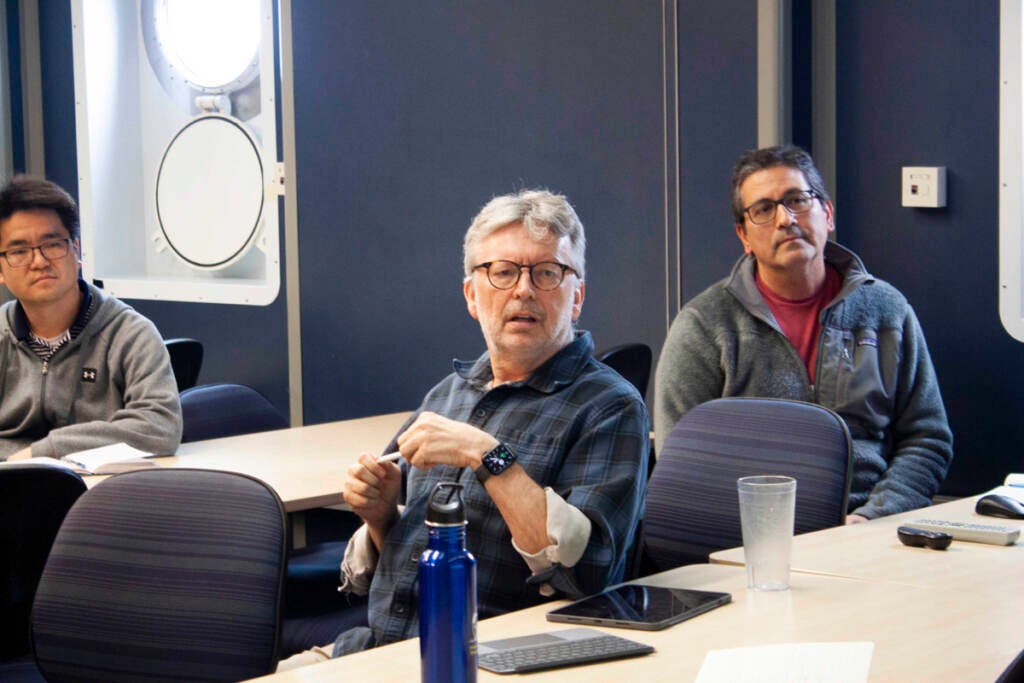
The late scientist’s work, even his spirit, looms large over this mission. Hodell never collaborated directly with Shackleton nor went on a coring expedition with him. But Abrantes did.
She was on a ship with Shackleton in the mid-1990s and says they basically worked around the clock, pulling up cores and taking samples to study.
“We would be four hours working, four hours sampling, four hours resting,” she said, “And we sampled, also together, the two of us, and it was a lot of fun.”
She has a photo of them preparing to drop a pipe off the side of a boat. In the photo, Shackleton’s in shorts and sandals — which would not be allowed today — for safety reasons. Abrantes says he only put on lace-up shoes when he was performing music.
“He took it so seriously, that was the only time he would put (on) a suit and wear shoes,” she said of his musical pursuits. Alongside his scientific success, he was also an accomplished woodwind player and collector.
“He once told me that music was his life, science was his hobby.”
Shackleton’s groundbreaking work inspired many, including the two dozen scientists Abrantes and Hodell gathered to drill the Iberian margin and unlock their own discoveries. The scientists hope to show how the Earth’s climate changed every one-thousand years over the past 3-to-4 million years, which would be a super detailed record and is an enormous undertaking. They may also learn how those layers of mud document changes in Earth’s orbit.
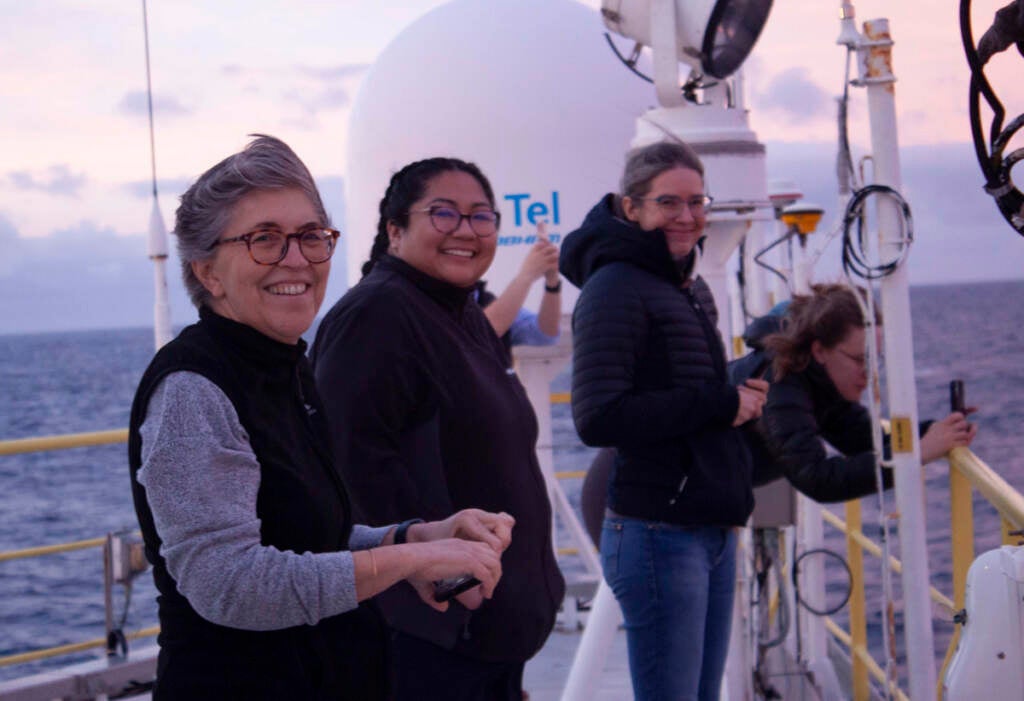
Cores on deck
After about two weeks at sea, tube after tube of mud has come up from the bottom, sometimes as many as 50 cores per hole. Each core is about 30 feet long and the crew drills several holes at each location. Every few hours they’re handing cores off to science technicians, who are skilled scientists and seasoned sailors responsible for running the ship’s labs, curating the cores, and supporting the science party. As each core arrives on the deck, the technicians carefully measure it and then cut it into three-to four-foot-long sections. These are carefully labeled with a laser engraver.
Then, the sections begin their journey through the ship’s many labs on tracks that feed them into different machines. After that, the technicians use a power saw to cut the cylinders lengthwise and split them apart. At last, the cores are splayed open, and the sediment inside is exposed to human eyes for the first time. Each core is different.
“We have from blue sediment to totally white chalk full of forams to reddish sediment full of glass,” Abrantes said. Certain species of forams, or foraminifera, and nannofossils are known to correlate with specific time periods. So, when the experts on microfossils identify the species, they can roughly establish the age of the sediment.
Quickly it becomes clear the scientists have far exceeded the goal of 3-to-5-million-year-old mud. In the core description lab, Jerry McManus, a professor at Columbia University, sees unexpected things in the mud.
“We suddenly recovered several cores that were quite a bit older than 10 million years, maybe 14 million years,” he said. “And they were spectacularly variable.”
Even with an untrained eye, light and dark layers of greens and browns are visible. And the mud harbors all sorts of goodies inside.
“In the sands were big chunks of mollusk shells and things that clearly would have tumbled down from somewhere very close to the shore, or very close to the surface,” McManus said. “And this was all a big surprise, and these were beautiful sediments.”
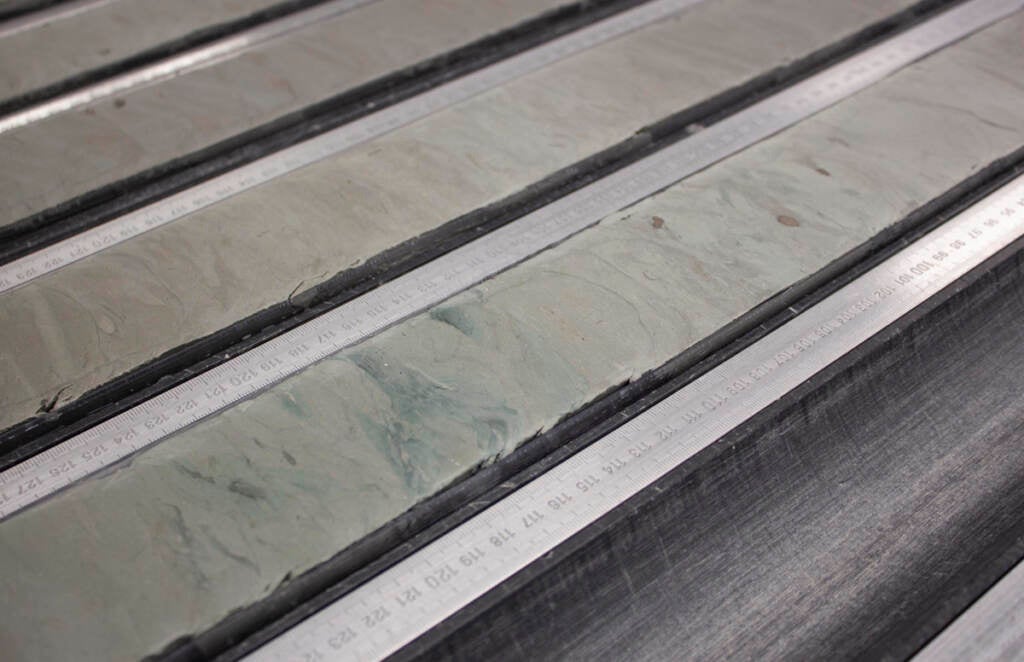
Shipboard collaboration
Despite the thrill of the unexpected, the pace of shipboard science can be relentless. Everyone works a 12-hour shift in support of the ultimate goal: to maximize how much sediment is collected.
Abrantes and Hodell hand-picked the members of the science party, who come from nearly a dozen countries. They sought a team with wide-ranging experience and expertise. Abrantes says that’s how Nick Shackleton worked, too. She says Shackleton always modeled working together as a team toward the best science, putting aside competition.
“I think this is a really good lesson for the young people,” she said, noting the expedition includes several graduate students and postdoctoral researchers, in addition to early-career faculty members and long-time professors with many research cruises behind them.
Postdoctoral researcher May Huang grew up in Taiwan and did her PhD in Hong Kong. When she joined the expedition, she was completing a postdoc at the Smithsonian, and now she’s begun another postdoc at Princeton University. She previously sailed on the JOIDES Resolution as a graduate student and this time shares a two-person lab with a tenured professor from Brown University, Tim Herbert. Huang said she values working on a team that dissolves the academic hierarchy.
“When I grew up, we were not allowed to kind of ask questions, or sort of challenge our seniors,” Huang said. “Out here, everyone has different experience, but everyone is equal, and everyone can contribute in their own way.”
She knows how to write simple code. That skill allowed her to execute an idea Herbert had but hadn’t figured out how to pursue.
Graduate student Celeste Pallone, who’s working on a PhD with Jerry McManus at Columbia, also finds the shipboard atmosphere fosters close relationships.
“It was great to be able to talk to, and actually become friends with people who are at different stages in their scientific careers,” Pallone said.
On the ship, Pallone works in the core description lab on the opposite shift from McManus. But back home, she already has her PhD project underway using a core from off the Pacific coast of South America. McManus says, once again, Nick Shackleton’s legacy hovers. Back in 2004, he and Shackleton were supposed to sail together on the JOIDES Resolution, but Shackleton got sick and couldn’t go. McManus says Shackleton was really only interested in one site on that expedition. They drilled it without him.
“And the connection to this very day is that Celeste Pallone is doing her thesis work on that same site,” McManus said, “which was the one site that Nick Shackleton wanted to study from that expedition.”
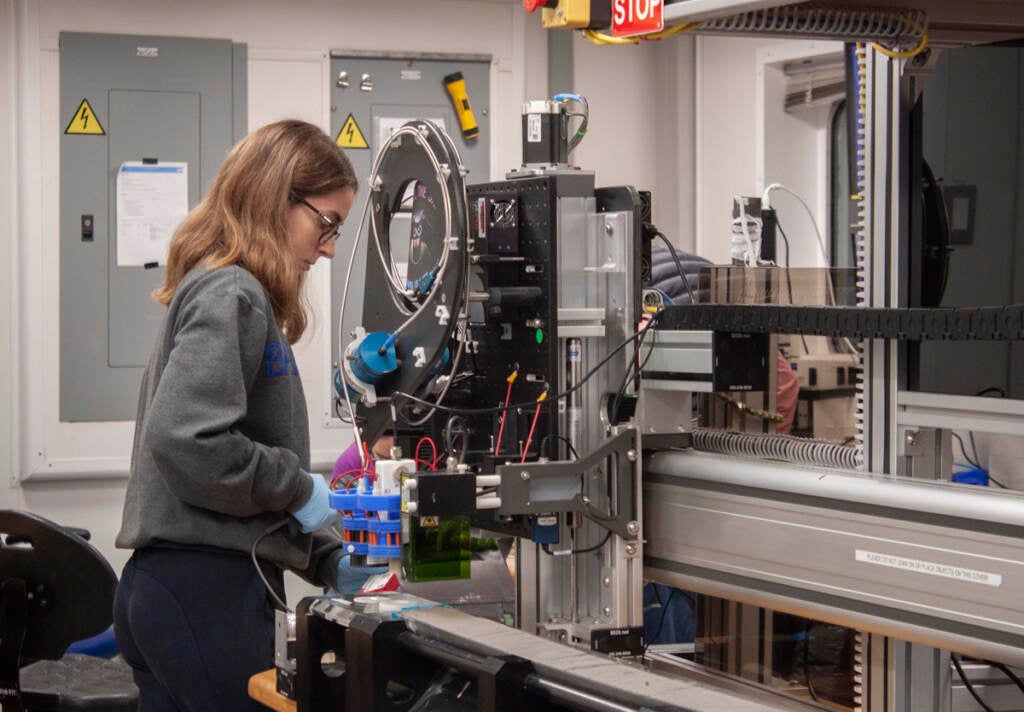
Miles of mud
After two months at sea, the scientists have drilled four sites, collecting vast quantities of mud. They’ve revised their original research plans in response to unexpected lines of inquiry that have emerged from the cores.
Finally, they gather to bring in the final core. Everyone’s a little giddy. They’ve collected four miles’ worth of mud. Once the final core is handed off — this time the technicians invite the scientists to work alongside them on the catwalk — Abrantes turns to the group.
“Hey guys, we did it!” she said. The mud collecting is over, and the expedition is nearing its finish. Three days later, tugs pull the JOIDES Resolution into the port of Tarragona, Spain. Pallets of cores are off-loaded. They’ll be shipped to labs in Europe and the United States. The scientists head home.
While the seafaring adventure is over, the discoveries have yet to really begin. David Hodell, expedition co-chief scientist, cautions they could take a while.
“There might be some splashy, flashy things that emerge shortly after the expedition,” he said. “But I’m more interested in the slow burn stuff.”
Those are the studies that might take years, or decades. Long enough for the youngest members of this crew to mentor another generation of paleoceanographers, further extending Nick Shackleton’s legacy.
Amy Mayer, a freelance journalist, was the onboard outreach officer for Expedition 397.
WHYY is your source for fact-based, in-depth journalism and information. As a nonprofit organization, we rely on financial support from readers like you. Please give today.






